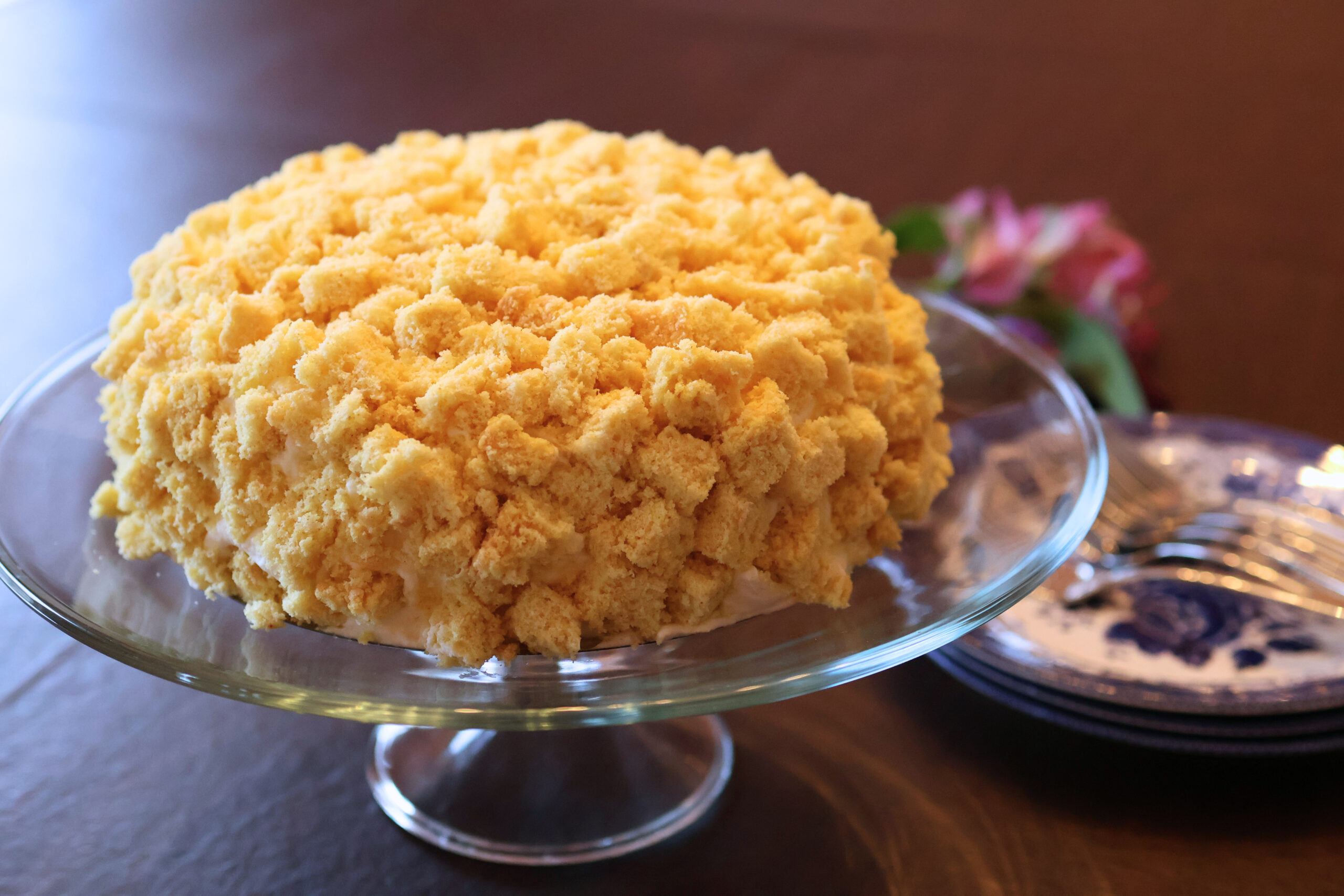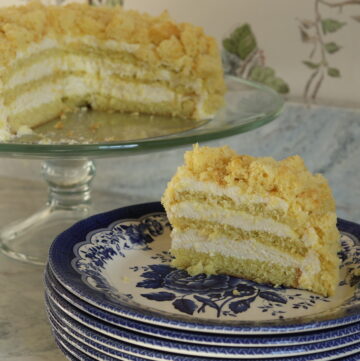

Italian Mimosa Cake | Torta Mimosa
An Italian cake from Rieti, Italy, that is now associated with and enjoyed on March 8, International Women's Day (Festa della Donna). The cake is made with three layers of pan di Spagna sponge cake soaked with liqueur or fruit juice and filled with a lightened pastry cream. Pieces of sponge cake are arranged on the top and sides of the cake to resemble the mimosa flower, the symbol of International Women's Day.
Ingredients
Pastry Cream
- 500 ml whole milk 2 cups + 2 tbsp
- Peel of 1 lemon
- 4 egg yolks
- 70 g granulated sugar ⅓ cup
- 30 g cornstarch or potato starch ¼ cup
- 1 tsp vanilla extract
Pan di Spagna
- 6 large eggs
- 130 g all-purpose flour 1 cup
- 130 g cornstarch or potato starch 1 cup
- 260 g granulated sugar 1½ cups
- 1 teaspoon vanilla extract
- 1 pinch of salt
- ½ tsp ground turmeric (for color) optional
- 1 tsp baking powder optional
Sugar Syrup
- 125 ml water ½ cup
- 2 tbsp granulated sugar
- 2 tbsp liqueur such as Limoncella, Orangecello, Grand Marnier, Strega, or Maraschino
- orange juice or pineapple juice can be substituted for the sugar syrup to create a non-alcoholic cake
Chantilly Cream
- 450 ml heavy cream 2 cups
- 60 g powdered sugar 5 tbsp
Instructions
Making the Pastry Cream
- Making the pastry cream first will give it enough time to chill while you're preparing the rest of the cake.
- Heat the milk and lemon peel in a medium saucepan just until it gently bubbles around the edges. Don't let it boil or it will form a skin when it cools down.
- Turn off the heat and skim out the lemon peel. Discard the peel.
- In a separate bowl, whisk together the egg yolks, sugar, and cornstarch until it is smooth and the sugar granules are no longer visible.
- Now, temper the egg mixture by slowly drizzling in the hot milk while whisking vigorously. Start with a couple of drips of milk and then create a steady stream while whisking. Whisk in about 175ml (¾ cup) of the hot milk. Then, pour the tempered eggs into the rest of the milk in the saucepan, whisking while you do this.
- Turn the heat back on to medium-low and whisk continuously. The mixture should eventually thicken to a pudding-like consistency. Once it reaches this stage, let it continue to bubble and burp for about 3 minutes. Whisk often to keep it from burning.
- Remove the pot from the heat and whisk in the vanilla extract. Pour the pastry cream into a shallow dish and place plastic wrap directly on the surface to prevent it from forming a skin as it cools. Chill in the refrigerator for about 2 hours, or until chilled through.
Making the Pan di Spagna
- Prepare two 8 inch (20 cm) cake pans by lining the bottoms with parchment paper. Do not grease the pans, as this may cause the cakes to fall in the oven.
- Add the eggs, sugar, and vanilla into the bowl of a stand mixer fitted with a whisk attachment. Beat the mixture on medium speed for 15-20 minutes. The end result should be pale yellow, voluminous, and create ribbons on the surface when drizzled over it.
- Preheat the oven to 320℉ / 160℃.
- In a separate bowl, sift together the flour, cornstarch, salt, turmeric and baking powder, if using. See note below regarding these last two ingredients. Whisk the sifted ingredients together.
- Using a balloon whisk, fold the dry ingredients into the egg mixture 1-2 tablespoons at a time. Do this slowly and gently to avoid deflating the eggs.
- Once there are no flour streaks left in the batter, divide the batter evenly between the two cake pans. Swirl a toothpick through the batter to release any air bubbles. Do not bang the cake pans on your work top to achieve this. It will partially deflate the eggs.
- Bake the cakes on the middle rack of the oven for 40 minutes. Do not open the oven while it is baking, or the cakes may deflate.
- When the baking time is over, partially prop the door of the oven open for ten minutes before removing the cakes. This will help keep the cakes from deflating when they hit the cool air of the kitchen. After ten minutes, remove the cakes and place the pans upside down on a cooling rack. The cakes will slightly deflate when you remove them from the oven, but cooling them upside down will prevent them from losing too much volume during the cooling process.
Making the Sugar Syrup
- Pour the water and sugar into a small saucepan. Turn the heat on medium and let it come to a boil. Turn the heat down until you reach a simmer. Whisk and continue simmering until the sugar is dissolved. This should only take a couple of minutes.
- Pour the hot syrup into a bowl and let it cool down. Once it's warm, and no longer hot, stir in two tablespoons of the liqueur of your choice.
- If you are using fruit juice instead of alcohol for your recipe, skip making the sugar syrup and simply measure out 125ml (½ cup) of the orange or pineapple juice and set aside.
Making the Chantilly Cream
- Add heavy cream to the bowl of your stand mixer fitted with a whisk attachment. Beat on medium speed and add the powdered sugar 1 tablespoon at time until stiff peaks form.
- Remove the chilled pastry cream from the fridge and transfer it to a large bowl. Whisk it to break up the solid mass. Fold the whipped cream into the pastry cream in thirds, gently folding until all streaks of pastry cream are gone. Cover with plastic wrap and store in the fridge until you're ready to assemble the cake.
Assembling the Cake
- Remove both cakes from the pans. Gently remove the crust from the tops and sides of each cake.
- Dice one of the cakes into ½ inch (1.25 cm) cubes. Set the cubes aside in a covered bowl until you're ready to use them. Alternatively, some Italians decorate their mimosa cake with crumbs instead of cubes. You could rub the pieces together to create cake crumbs, if you would prefer to decorate your cake with crumbs.
- Slice the second cake horizontally into three layers. Place the sturdiest looking layer on the bottom of your cake decorating surface. Drizzle one third of the sugar syrup over the cake layer. Then, spoon on and smooth just to the edges one third of the cream. Repeat this process again with the second layer. Place the final layer on top, drizzle with the rest of the sugar syrup, and smooth the last third of the cream over the top and sides of the cake.
- Take handfuls of the cake cubes and press them into the sides and top of the cake until all of the cream is covered with the cubes. Transfer your cake to a covered cake dish and store in the refrigerator for at least two hours before serving. Letting the cake sit in the fridge overnight before serving produces the best results, however. This cake lasts up to 3 days.
Video
Notes
- Ground Turmeric: This cake is made to resemble the yellow mimosa flower. If you would like to add a little extra yellow color to your cake, you can add ½ teaspoon of ground turmeric to the dry ingredients of the sponge cake. This will not add any turmeric flavor, but simply enhance the yellow color of the sponge.
- Baking Powder: Traditionally pan di Spagna cake is made with zero leavening agents. It is leavened only by the air in the eggs. However, because of the this, it tends to be a finicky cake. I’ve made this many times and, about half of the time, my cake falls after baking. To avoid this, I employ a small cheat–I add 1 teaspoon of baking powder to the dry ingredients. In the recipe, I’ve left it up to you whether or not you would like to add the baking powder.

Leave a Reply